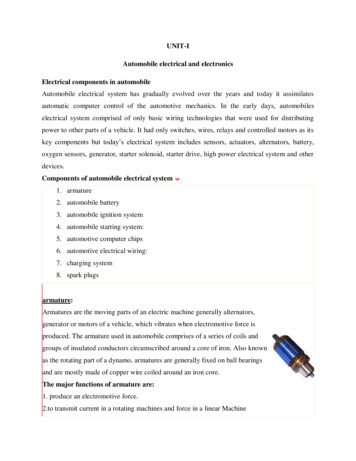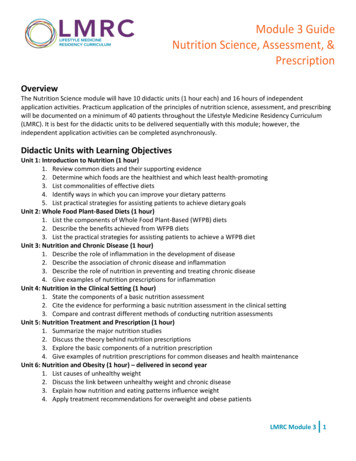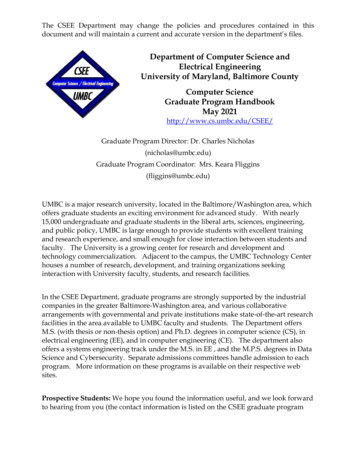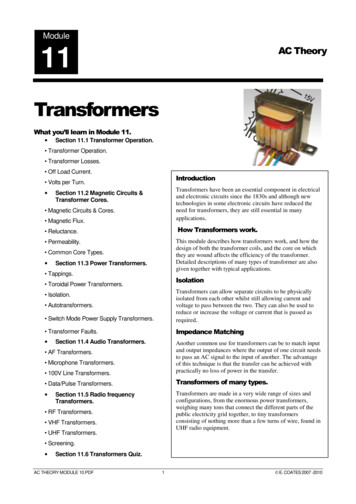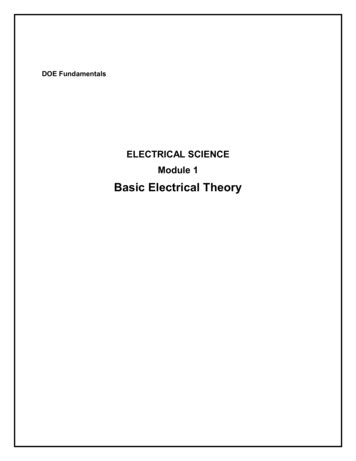
Transcription
DOE FundamentalsELECTRICAL SCIENCEModule 1Basic Electrical Theory
Basic Electrical TheoryTABLE OF CONTENTST able of Co nte ntsTABLE OF CONTENTS . iLIST OF FIGURES .ivLIST OF TABLES .viREFERENCES . viiOBJECTIVES . viiiTERMINAL OBJECTIVE . viiiENABLING OBJECTIVES . viiiATOM AND ITS FORCES . 1The Atom . 1Electrostatic Force . 2The First Law of Electrostatics . 3Electrostatic Field . 3Potential Difference . 5Free Electrons . 6Summary . 8ELECTRICAL TERMINOLOGY . 9Conductors . 9Insulators . 9Resistors. 9Voltage . 10Current. 10Real and Ideal Sources . 12Summary . 12UNITS OF ELECTRICAL MEASUREMENT . 13System Internationale (SI) Metric System . 13Voltage . 14Current. 14Resistance . 14Ohm's Law . 14iES-01
Basic Electrical TheoryConductance . 16Power . 16Inductance . 17Capacitance . 17Summary . 18METHODS OF PRODUCING VOLTAGE (ELECTRICITY) . 19Electrochemistry . 19Static Electricity . 20Magnetic Induction. 21Piezoelectric Effect . 21Thermoelectricity . 22Photoelectric Effect . 23Thermionic Emission . 24Summary . 26MAGNETISM . 27Magnetism . 27Magnetic Flux . 29Magnetic Flux Density . 29Magnetic Materials. 29Electromagnetism . 30Polarity of a Single Conductor . 31Magnetic Field and Polarity of a Coil . 31Magnetomotive Force . 32Field Intensity. 33Reluctance. 34Summary . 35MAGNETIC CIRCUITS . 36Magnetic Circuits . 36BH Magnetization Curve . 37Hysteresis . 39Magnetic Induction. 39iiES-01
Basic Electrical TheoryFaraday's Law of Induced Voltage . 40Lenz's Law . 41Summary . 42ELECTRICAL SYMBOLS . 43Symbols . 43Appendix A: Metric System and Powers of Ten . A1Metric System . A1Metric Prefixes . A2Powers of Ten. A3iiiES-01
Basic Electrical TheoryLIST OF FIGURESFigure 1The Atom . 1Figure 2The Carbon Atom . 2Figure 3Electrostatic Force . 2Figure 4Electrostatic Field . 3Figure 5Electrostatic Field Between Two Charges of Opposite Polarity . 4Figure 6Electrostatic Field Between Two Charges of Like Polarity . 4Figure 7Potential Difference Between Two Charged Objects . 5Figure 8Energy Shells and Electron Quota . 6Figure 9Electron Flow Through a Copper Wire with a Potential Difference . 11Figure 10Potential Difference Across a Conductor Causes a Current to Flow . 11Figure 11Voltaic Chemical Cell . 20Figure 12Static Electricity . 20Figure 13Generator - Electromagnetic Induction . 21Figure 14Pressure Applied to Certain Crystals Produce an Electric Charge . 22Figure 15Heat Energy Causes Copper to Give up Electrons to Zinc . 23Figure 16Producing Electricity from Light Using a Photovoltaic Cell . 24Figure 17Vacuum Tube Diode . 25Figure 18Electron Spinning Around Nucleus Produces Magnetic Field . 27Figure 19Magnetic Domains . 28Figure 20The Law of Magnetic Attraction and Repulsion . 28Figure 21The Magnetic Field Produced by Current in a Conductor . 31Figure 22Left-hand Rule for Current Carrying Conductors . 31Figure 23Left-hand Rule for Coils . 32Figure 24Left-hand Rule to Find North Pole of an Electromagnet . 33Figure 25Different Physical Forms of Electromagnets . 35Figure 26Magnetic Current with Closed Iron Path . 38Figure 27Typical BH Curve for Two Types of Soft Iron . 39ivES-01
Basic Electrical TheoryFigure 28Hysteresis Loop for Magnetic Materials . 41Figure 29Induced EMF . 42Figure 30Electrical Symbols . 46vES-01
Basic Electrical TheoryLIST OF TABLESTable A-1Base Units of the International Metric System . A-1Table A-2Supplementary SI Units . A-2Table A-3Derived SI Units . A-3Table A-4Metric Prefixes Used in Electricity . A-4Table A-5Powers of 10 . A-5Table A-6Metric Prefixes Expressed as Powers of 10 . A-8viES-01
Basic Electrical TheoryREFERENCES Gussow, Milton, Schaum's Outline of Basic Electricity, 2nd Edition, McGraw-Hill. Academic Program for Nuclear Power Plant Personnel, Volume I & II, Columbia,MD: General Physics Corporation, Library of Congress Card #A 326517, 1982. Sienko and Plane, Chemical Principles and Properties, 3rd Edition, McGraw-Hill. Nasar and Unnewehr, Electromechanics and Electric Machines, 2nd Edition, JohnWiley and Sons. Nooger and Neville Inc., Van Valkenburgh, Basic Electricity, Vol. 5, Hayden BookCompany. Lister, Eugene C., Electric Circuits and Machines, 7th Edition, McGraw-Hill. Croft, Hartwell, and Summers, American Electricians’ Handbook, 16th Edition,McGraw-Hill. Mason, C. Russel, The Art and Science of Protective Relaying, John Wiley andSons. Mileaf, Harry, Electricity One - Seven, Revised 2nd Edition, Hayden BookCompany. Buban and Schmitt, Understanding Electricity and Electronics, 3rd Edition,McGraw-Hill. Kidwell, Walter, Electrical Instruments and Measurements, McGraw-Hill.viiES-01
Basic Electrical TheoryOBJECTIVESTERMINAL OBJECTIVE1.0Given a simple electrical circuit, APPLY basic electrical theory fundamentalprinciples to describe circuit operation.ENABLING OBJECTIVES1.1DESCRIBE the following terms:a. Electrostatic forceb. Electrostatic fieldc. Potential differenced. Electromotive force (EMF)e. Ion charge1.2DEFINE the following terms:a. Conductorb. Insulatorc. Resistord. Electron current flowe. Conventional current flowf. Direct current (DC)g. Alternating current (AC)h. Ideal sourcei. Real source1.3DESCRIBE the following electrical parameters, including the unit ofmeasurement and the relationship to other parameters.a. Voltageb. Currentc. Resistanced. ConductanceviiiES-01
Basic Electrical Theorye. Powerf. Inductanceg. Capacitance1.4Given any two of the three component values of Ohm's Law, DETERMINE theunknown component value.1.5DESCRIBE how the following methods produce a voltage:a. Electrochemistryb. Static electricityc. Magnetic Inductiond. Piezoelectric effecte. Thermoelectricityf. Photoelectric effectg. Thermionic emission1.6DEFINE the following terms:a. Magnetic fluxb. Magnetic flux densityc. Weberd. Permeabilitye. Magnetomotive force (mmf)f. Ampere turnsg. Field intensityh. Reluctance1.7DESCRIBE the following materials as they relate to permeability, including anexample and an approximate relative permeability.a. Ferromagnetic materialsb. Paramagnetic materialsc. Diamagnetic materials1.8EXPLAIN the physical qualities of a simple magnetic circuit, includingrelationships of qualities and units of measurements.1.9Given the physical qualities of a simple magnetic circuit, CALCULATE theunknown values.ixES-01
Basic Electrical Theory1.10DESCRIBE the shape and components of a BH magnetization curve.1.11EXPLAIN the cause of hysteresis losses.1.12Given Faraday's Law of induced voltage:a. DESCRIBE how varying parameters affect induced voltage.b. CALCULATE voltage induced in a conductor moving through a magneticfield.1.13STATE Lenz's Law of induction.1.14Given a standard electrical symbol, IDENTIFY the component that the symbolrepresents. The symbols will be for the following components:a.Resistorm. Fuseb.Capacitorn.Junctionc.Inductoro.AC voltage err.Wattmeterg.Switchs.Relay operated contactsh.Transistort.Potential transformeri.Rheostatu.Current transformerj.Diodev.Wye (Y) connectionk.Ground connectionsw. Delta (Δ) connectionl.Vacuum tubex.Light bulby.BatteryxES-01
Basic Electrical TheoryAtom and its ForcesATOM AND ITS FORCESWhat is electricity? Electricity is defined as "the flow of electrons through simplematerials and devices" or "that force which moves electrons." Scientists thinkelectricity is produced by very tiny particles called electrons and protons. Theseparticles are too small to be seen, but exist as subatomic particles in the atom.To understand how they exist, you must first understand the structure of theatom.EO 1.1DESCRIBE the following terms:a. Electrostatic forceb. Electrostatic fieldc. Potential differenced. Electromotive force (EMF)e. Ion chargeThe AtomElements are the basicbuilding blocks of all matter.The atom is the smallestparticle to which an elementcan be reduced while stillkeeping the properties of thatelement. An atom consists ofa positively charged nucleussurrounded by negativelycharged electrons, so that theatom as a whole is electricallyneutral. The nucleus iscomposed of two kinds ofsubatomic particles, protonsand neutrons, as shown inFigure 1. The proton carries asingle unit positive charge equal in magnitude to the electron charge. The neutron isslightly heavier than the proton and is electrically neutral, as the name implies. Thesetwo particles exist in various combinations, depending upon the element involved. The1ES-01
Basic Electrical TheoryAtom and its Forceselectron is the fundamental negative charge (-) of electricity and revolves around thenucleus, or center, of the atom in concentric orbits, or shells.The proton is the fundamental positivecharge ( ) of electricity and is locatedin the nucleus. The number of protonsin the nucleus of any atom specifiesthe atomic number of that atom or ofthat element. For example, the carbonatom contains six protons in itsnucleus; therefore, the atomic numberfor carbon is six, as shown in Figure 2.In its natural state, an atom of anyelement contains an equal number ofelectrons and protons. The negativecharge (-) of each electron is equal inmagnitude to the positive charge ( ) ofeach proton; therefore, the twoopposite charges cancel, and the atomis said to be electrically neutral, or inbalance.Electrostatic ForceOne of the mysteries of the atom is that the electron and the nucleus attract each other.This attraction is called electrostatic force, the force that holds the electron in orbit. Thisforce may be illustrated with lines as shown in Figure 3.Figure 3 Electrostatic Force2ES-01
Basic Electrical TheoryAtom and its ForcesWithout this electrostatic force, the electron, which is traveling at high speed, could notstay in its orbit. Bodies that attract each other in this way are called charged bodies. Asmentioned previously, the electron has a negative charge, and the nucleus (due to theproton) has a positive charge.The First Law of ElectrostaticsThe negative charge of the electron is equal, but opposite to, the positive charge of theproton. These charges are referred to as electrostatic charges. In nature, unlike charges(like electrons and protons) attract each other, and like charges repel each other. Thesefacts are known as the First Law of Electrostatics and are sometimes referred to as thelaw of electrical charges. This law should be remembered because it is one of the vitalconcepts in electricity.Some atoms can lose electrons and others can gain electrons; thus, it is possible totransfer electrons from one object to another. When this occurs, the equal distribution ofnegative and positive charges no longer exists. One object will contain an excess ofelectrons and become negatively charged, and the other will become deficient inelectrons and become positively charged. These objects, which can contain billions ofatoms, will then follow the same law of electrostatics as the electron and protonexample shown above. The electrons that can move around within an object are said tobe free electrons and will be discussed in more detail in a later section. The greater thenumber of these free electrons an object contains, the greater its negative electriccharge. Thus, the electric charge can be used as a measure of electrons.Electrostatic FieldA special force is acting betweenthe charged objects discussedabove. Forces of this type are theresult of an electrostatic field thatexists around each chargedparticle or object. Thiselectrostatic field, and the force itcreates, can be illustrated withlines called "lines of force" asshown in Figure 4.Figure 4 Electrostatic Field3ES-01
Basic Electrical TheoryAtom and its ForcesCharged objects repel or attract each other because of the way these fields acttogether. This force is present with every charged object. When two objects of oppositecharge are brought near one another, the electrostatic field is concentrated in the areabetween them, as shown in Figure 5. The direction of the small arrows shows thedirection of the force as it would act upon an electron if it were released into the electricfield.Figure 5 Electrostatic Field Between Two Charges of Opposite PolarityWhen two objects of like charge are brought near one another, the lines of force repeleach other, as shown in Figure 6.Figure 6 Electrostatic Field Between Two Charges of Like PolarityThe strength of the attraction or of the repulsion force depends upon two factors: (1) theamount of charge on each object, and (2) the distance between the objects. The greaterthe charge on the objects, the greater the electrostatic field. The greater the distance4ES-01
Basic Electrical TheoryAtom and its Forcesbetween the objects, the weaker the electrostatic field between them, and vice versa.This leads us to the law of electrostatic attraction, commonly referred to as Coulomb'sLaw of electrostatic charges, which states that the force of electrostatic attraction, orrepulsion, is directly proportional to the product of the two charges and inverselyproportional to the square of the distance between them as shown in Equation 1-1.(1-1)whereF force of electrostatic attraction or prepulsion (Newtons)k constant of proportionality (N-m2/Coulomb 2)q1 charge of first particle (Coulombs)q2 charge of second particle (Coulombs)d distance between two particles (Meters)If q1 and q2 are both eitherpositively or negativelycharged, the force isrepulsive. If q1 and q2 areopposite polarity or charge,the force is attractive.Potential DifferencePotential difference is theterm used to describe howlarge the electrostatic forceis between two chargedobjects. If a charged body isplaced between two objectswith a potential difference, the charged body will try to move in one direction, dependingupon the polarity of the object. If an electron is placed between a negatively-chargedbody and a positively-charged body, the action due to the potential difference is to pushthe electron toward the positively-charged object. The electron, being negativelycharged, will be repelled from the negatively-charged object and attracted by thepositively-charged object, as shown in Figure 7.5ES-01
Basic Electrical TheoryAtom and its ForcesDue to the force of its electrostatic field, these electrical charges have the ability to dowork by moving another charged particle by attraction and/or repulsion. This ability to dowork is called "potential"; therefore, if one charge is different from another, there is apotential difference between them. The sum of the potential differences of all chargedparticles in the electrostatic field is referred to as electromotive force (EMF).The basic unit of measure of potential difference is the "volt." The symbol for potentialdifference is "V," indicating the ability to do the work of forcing electrons to move.Because the volt unit is used, potential difference is also called "voltage." The unit voltwill be covered in greater detail in the next chapter.Free ElectronsElectrons are in rapid motion around the nucleus. While the electrostatic force is tryingto pull the nucleus and the electron together, the electron is in motion and trying to pullaway. These two effects balance, keeping the electron in orbit. The electrons in an atomexist in different energy levels. The energy level of an electron is proportional to itsdistance from the nucleus. Higher energy level electrons exist in orbits, or shells, thatare farther away from the nucleus. These shells nest inside one another and surroundthe nucleus. The nucleus is the center of all the shells. The shells are lettered beginningwith the shell nearest the nucleus: K, L, M, N, 0, P, and Q. Each shell has a maximumnumber of electrons it can hold. For example, the K shell will hold a maximum of twoelectrons and the L shell will hold a maximum of eight electrons. As shown in Figure 8,each shell has a specific number of electrons that it will hold for a particular atom.Figure 8 Energy Shells and Electron Quota6ES-01
Basic Electrical TheoryAtom and its ForcesThere are two simple rules concerning electron shells that make it possible to predictthe electron distribution of any element:1. The maximum number of electrons that can fit in the outermost shell of any atomis eight.2. The maximum number of electrons that can fit in the next-to-outermost shell ofany atom is 18.An important point to remember is that when the outer shell of an atom contains eightelectrons, the atom becomes very stable, or very resistant to changes in its structure.This also means that atoms with one or two electrons in their outer shell can loseelectrons much more easily than atoms with full outer shells. The electrons in theoutermost shell are called valence electrons. When external energy, such as heat, light,or electrical energy, is applied to certain materials, the electrons gain energy, becomeexcited, and may move to a higher energy level. If enough energy is applied to theatom, some of the valence electrons will leave the atom. These electrons are called freeelectrons. It is the movement of free electrons that provides electric current in a metalconductor. An atom that has lost or gained one or more electrons is said to be ionizedor to have an ion change. If the atom loses one or more electrons, it becomes positivelycharged and is referred to as a positive ion. If an atom gains one or more electrons, itbecomes negatively charged and is referred to as a negative ion.7ES-01
Basic Electrical TheoryAtom and its ForcesSummaryThe important information contained in this chapter is summarized below.Forces Around Atoms Summary Electrostatic Force - force that holds an electron in orbit around a nucleus Electrostatic Field - force acting between charged objects that causes them torepel or attract Potential Difference - measures how large the electrostatic force is between twocharged objects. According to Coulomb's Law, charged bodies attract or repeleach other with a force that is directly proportional to the product of their chargesand is inversely proportional to the square of the distance between them. Electromotive Force (EMF) - sum of the potential differences of all chargedparticles in an electrostatic field Ion Charge - dependent on the loss or gain of free electrons (if an atom gains anelectron - negative ion charge; if an atom loses an electron positive ion charge)8ES-01
Basic Electrical TheoryElectrical TerminologyELECTRICAL TERMINOLOGYKnowledge of key electrical terminology is necessary to fully understandprinciples in electrical science.EO 1.2DEFINE the following terms:a. Conductorb. Insulatorc. Resistord. Electron current flowe. Conventional current flowf. Direct current (DC)g. Alternating current (AC)h. Ideal sourcei. Real sourceConductorsConductors are materials with electrons that are loosely bound to their atoms, ormaterials that permit free motion of a large number of electrons. Atoms with only onevalence electron, such as copper, silver, and gold, are examples of good conductors.Most metals are good conductors.InsulatorsInsulators, or nonconductors, are materials with electrons that are tightly bound to theiratoms and require large amounts of energy to free them from the influence of thenucleus. The atoms of good insulators have their valence shells filled with eightelectrons, which means they are more than half filled. Any energy applied to such anatom will be distributed among a relatively large number of electrons. Examples ofinsulators are rubber, plastics, glass, and dry wood.ResistorsResistors are made of materials that conduct electricity, but offer opposition to currentflow. These types of materials are also called semiconductors because they are neithergood conductors nor good insulators. Semiconductors have more than one or two9ES-01
Basic Electrical TheoryElectrical Terminologyelectrons in their valence shells, but less than seven or eight. Examples ofsemiconductors are carbon, silicon, germanium, tin, and lead. Each has four valenceelectrons.VoltageThe basic unit of measure for potential difference is the volt (symbol V), and, becausethe volt unit is used, potential difference is called voltage. An object's electrical charge isdetermined by the number of electrons that the object has gained or lost. Because sucha large number of electrons move, a unit called the "coulomb" is used to indicate thecharge. One coulomb is equal to 6.28 x 10 18 (billion, billion) electrons. For example, ifan object gains one coulomb of negative charge, it has gained6,280,000,000,000,000,000 extra electrons. A volt is defined as a difference of potentialcausing one coulomb of current to do one joule of work. A volt is also defined as thatamount of force required to force one ampere of current through one ohm of resistance.The latter is the definition with which we will be most concerned in this module.CurrentThe density of the atoms in copper wire is such that the valence orbits of the individualatoms overlap, causing the electrons to move easily from one atom to the next. Freeelectrons can drift from one orbit to another in a random direction. When a potentialdifference is applied, the direction of their movement is controlled. The strength of thepo
Basic Electrical Theory viii ES-01 OBJECTIVES TERMINAL OBJECTIVE 1.0 Given a simple electrical circuit, APPLY basic electrical theory fundamental principles to describe circuit operation. ENABLING OBJECTIVES 1.1 DESCRIBE the following terms: a. Electrostatic force b. Electrostatic fiel


